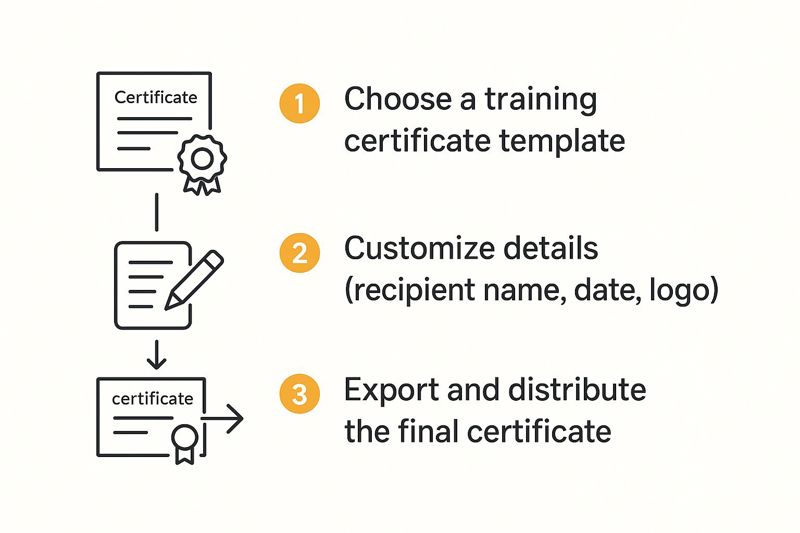A polished training certificate template is much more than a simple digital file. It’s a powerful symbol of your learners' hard work and a tangible asset for your brand. This isn't just a receipt for a completed course; it's a verifiable credential that people are genuinely proud to display.
Why a Professional Certificate Template Matters More Than Ever
Let's be real for a moment. A certificate is often the very last impression a learner has of your program. A flimsy, poorly designed document can instantly cheapen the value of the training they just invested their time and money into.
On the flip side, a sharp, professionally designed certificate elevates the entire experience. It’s not just about looking good. It’s about creating a credential that learners are excited to share on places like LinkedIn, and that employers immediately recognize as legitimate.
This is especially critical in today's skills-first job market. The demand for verifiable credentials has absolutely exploded with the rise of online learning. In fact, a recent report from Coursera found that micro-credentials and skill-specific certificates are now highly valued by over 90% of students and employers globally. You can dig into the full 2025 Global Skills Report from Coursera to see just how much the labor market is being reshaped by this trend.
Boosting Learner Motivation and Brand Credibility
A well-crafted certificate is a surprisingly powerful motivator. When participants know a prestigious-looking credential is waiting for them at the finish line, it can provide that extra push to see the course through. It shifts the certificate from being a simple proof of completion to a coveted award.
This feeling of accomplishment is what drives people to share their achievements, which acts as fantastic, organic marketing for your program.
Your certificate is a silent ambassador for your brand. It communicates your organization's commitment to quality, professionalism, and the value you place on your learners' achievements.
The anatomy of a credible certificate is something we’ve spent a lot of time thinking about. It’s the small details that work together to build trust and convey professionalism.
The Anatomy of a Credible Certificate
Here’s a breakdown of the essential components every training certificate template needs to be taken seriously.
| Component | Why It's Critical | Real-World Example |
|---|---|---|
| High-Resolution Branding | Prevents a cheap, pixelated look. It ensures your logo and brand elements appear crisp and official, reinforcing your brand's quality. | Using a vector or high-DPI version of your company logo, not a low-quality JPG pulled from your website. |
| Clear, Legible Fonts | Professional typography makes the certificate easy to read and lends an air of authority. Messy or overly decorative fonts can look amateurish. | Sticking to classic, readable fonts like Helvetica, Garamond, or Futura for names and course titles. |
| Learner's Full Name | This is the most personal part of the certificate. It must be prominently displayed and spelled correctly. | "Jonathan P. Doe" instead of "j. doe". |
| Course or Program Title | Clearly states what the achievement is for. Vague titles diminish the credential's value. | "Advanced Python for Data Science" is much stronger than just "Programming Course." |
| Completion Date | Provides context and proves when the skill was acquired, which is crucial for employers tracking recent qualifications. | "Date of Completion: October 26, 2024" |
| Unique Verification ID | This is a modern necessity. A unique ID or QR code allows anyone to quickly verify the certificate's authenticity, fighting fraud. | A unique alphanumeric code like CERT-A84B-91C3-DE7F linked to a verification page. |
Getting these elements right turns a simple document into a trusted credential.
Aligning with the Rise of Micro-Credentials
The idea of micro-credentials—those smaller, focused qualifications for specific skills—is no longer a niche concept. It’s mainstream. Your training certificate is a perfect real-world example of a micro-credential in action.
By designing a template that is both professional and easily verifiable, you’re aligning your program with this modern educational movement. It makes your training more attractive and valuable in a world where continuous upskilling is the new standard. For more inspiration, check out our other guide on templates for training certificates.
Gathering Your Essential Certificate Information

Before you start playing with colors and fonts for your training certificate template, let's get the core information locked down. This prep work is the absolute foundation of a legitimate, professional credential. I've seen it happen time and time again—skipping this step leads to last-minute chaos and a document that just doesn't feel authoritative.
Think of it as gathering your ingredients before you start cooking. It makes the whole process smoother. Let’s build your pre-flight checklist.
First up, you need the basics. These are the non-negotiable details that will show up on every single certificate you issue. They give the credential its identity and are critical for it to be taken seriously.
- Your Official Organization Name: Use the full, formal name of your company. Avoid abbreviations unless they’re part of your official brand.
- The Precise Training Title: Specificity is key here. "Marketing Course" is okay, but "Advanced Social Media Marketing for E-commerce" sounds far more impressive and valuable.
- The Recipient's Full Name: This is the most personal touch. Decide on a consistent format, like "First Name Last Name," and stick with it for all graduates.
Assembling Your Visual and Verification Assets
Once you have the text sorted, it's time to pull together your visual and verification elements. This is what separates a generic piece of paper from a secure, branded credential that people will be proud to display. A blurry logo or a missing signature can instantly kill a certificate's credibility.
You'll need high-resolution versions of all your brand assets. A pixelated logo screams "amateur," so hunt down a vector file (.SVG, .AI, .EPS) or at least a high-DPI PNG. The same goes for any digital signatures you plan on using from your instructors or directors.
A personal tip from my experience: never, ever skip the unique identifier. A simple Certificate ID or a QR code is non-negotiable for modern verification. It's the single best way to make your certificate tamper-proof and easy for employers to validate down the line.
Here’s a quick rundown of the assets you should have ready to go:
- High-Resolution Logo: The crisp, official version. No fuzzy JPEGs allowed.
- Digital Signatures: Clear, scanned, or digital signatures from the issuing authorities.
- Completion Date: This establishes the timeline and relevance of the skill learned.
- Unique Certificate ID: A system for generating a unique code for each recipient is crucial for verification.
Getting all this information and these assets collected and organized before you start designing will save you a massive headache. It ensures every certificate you issue is not just beautiful but also authoritative and trustworthy right from the start.
Designing a Certificate People Want to Share

This is where your brand’s credibility really gets put to the test. A generic, slapped-together design can make even the most valuable training feel cheap. Your goal should be to create a credential that feels genuinely prestigious, not like a participation trophy you’d get at a school sports day.
It all starts with thinking about the visuals. The design needs to scream professionalism and value from the first glance, making graduates eager to pop it on their LinkedIn profile or share it across their network. When that happens, your certificate transforms from a simple piece of paper into a powerful, self-spreading marketing tool.
Choosing Your Color Palette and Fonts
Your color palette should be a no-brainer—it needs to reflect your brand identity. I always recommend sticking to two or three core colors. This is usually your main brand color, a secondary accent, and a neutral like a clean white or a soft gray. This approach keeps things looking polished and reinforces your brand, not confuses it. Steer clear of loud, chaotic color schemes that just distract from the certificate’s real purpose.
Fonts are just as critical, and they have one job: be professional and, above all, readable.
- For headings and titles: Go for a clean, strong sans-serif font like Helvetica or a timeless serif like Garamond. The font choice here should communicate a sense of authority.
- For the recipient's name: A script font can add a nice personal touch, but make sure it’s still legible. Avoid anything overly flowery that’s hard to decipher at a glance.
- For body text: For things like the course description, use a simple, readable font that plays well with your main heading font.
The best designs I've seen find that sweet spot between elegance and readability. A certificate no one can read is just a pretty picture. It loses all its power if the key information isn't crystal clear.
It can be helpful to borrow principles from other professional documents. Thinking about structured template formats, for instance, teaches you the importance of a clean, predictable layout that gets information across efficiently.
Balancing the Layout with Key Elements
A great design isn't just about what you cram in; it's about how you arrange everything and use the space you’ve got. White space (or negative space) is your best friend here. It stops the certificate from looking cluttered and naturally guides the viewer’s eye to the most important bits, like the graduate’s name and their achievement.
You’ll also want to sprinkle in a few design elements that add a sense of officialdom without making the layout feel crowded.
Key Design Elements to Include:
- Borders: A simple, elegant border frames the content beautifully and gives the certificate a more traditional, formal feel.
- Seals or Emblems: A custom seal or emblem, often tucked in a corner or near a signature, adds a huge layer of authenticity. It just makes the whole thing feel more official.
- Watermarks: A subtle, low-opacity version of your logo in the background is a great way to boost branding without screaming at the viewer.
By carefully picking your colors, fonts, and layout elements, you can dodge the common design mistakes that cheapen a certificate. What you're left with is a professional training certificate template that doesn't just validate an achievement—it acts as a proud testament to the learner’s effort and your organization’s high standards.
Automating Certificate Creation to Save Hours of Work
Let’s be honest. Manually personalizing certificates for every single graduate is a soul-crushing task. It’s not just tedious—it’s a minefield of potential typos, data entry mistakes, and wasted hours you’ll never get back.
This is where you can make the single biggest efficiency leap in your entire training program: automation.
The real magic happens when you turn your beautifully designed, static certificate image into a dynamic training certificate template. Tools like OKZest are built for exactly this. They use something called merge tags (you might also know them as placeholders) to pull information from a simple list and place it directly onto your certificate design.
This completely changes your workflow. Instead of opening a design file, typing a name, saving it, and repeating that process fifty times, you set it up just once. After that, you can generate hundreds of unique, accurate, and professional certificates in minutes. This isn't just theory; it's a practical process that will fundamentally improve how you manage your credentials.
The Power of Merge Tags and Dynamic Content
Think of a merge tag as a small instruction you place on your certificate design. It’s a bit like a sticky note that tells the software, "Hey, go find the information in this column of my spreadsheet and put it right here." It works on the same principle as personalizing an email greeting.
For example, a placeholder like {{Full_Name}} on your design template will be automatically swapped out with "Jane Doe," "John Smith," and every other name on your graduate list. The power of this is that it works for much more than just names.
You can automate almost any piece of information on the certificate:
- {{Course_Title}} for the specific training program they finished.
- {{Completion_Date}} to automatically add the correct date.
- {{Certificate_ID}} to give each person a unique code for verification.
This flow shows just how simple it is to go from a single template to sending out certificates to everyone.

As you can see, automation boils the whole process down to just a few core actions. It completely removes the manual labor and potential for human error from the most time-consuming parts of the job.
Your Go-To Merge Tags for Certificate Automation
To get you started, here's a quick-reference guide to the most practical merge tags you can use to automate your training certificate template. The key is to match the tag in your design to a column header in your data source, like a Google Sheet or Excel file.
| Merge Tag Example | Your Data Source Column | What It Does |
|---|---|---|
{{Full_Name}} |
Full_Name | Automatically inserts the graduate's full name. |
{{Course_Title}} |
Course_Title | Adds the name of the course or program completed. |
{{Completion_Date}} |
Completion_Date | Populates the date the training was finished. |
{{Certificate_ID}} |
Certificate_ID | Generates a unique ID for verification purposes. |
{{Instructor_Name}} |
Instructor_Name | Adds the name of the instructor or course leader. |
With these tags in place, you're ready to connect your data and let the software do all the heavy lifting for you.
Connecting Your Data to Your Design
So, how does this connection actually work? It all starts with a simple spreadsheet.
You'll create a file in a program like Google Sheets or Excel, making sure the column headers match the information you want on your certificate. With your graduate data neatly organized, you upload the file to your automation tool. From there, you just map the columns from your sheet to the merge tags you placed on your training certificate template.
The software takes care of the rest, creating a unique, personalized image for every single row in your spreadsheet. To get the most out of this, it helps to understand the core principles of workflow automation, as they are key to making certificate generation truly seamless.
Even the United Nations recognizes the value of certified training, offering a UN Data Analytics Professional Certificate priced at $2,500 per person to upskill its staff. This shows just how important verifiable credentials are in today's professional world.
Automation isn't just about being faster; it's about being accurate and scalable. It ensures every single learner gets a perfectly personalized and error-free certificate, which boosts the professionalism of your entire program.
This approach lets even small teams manage large-scale training programs with the polish and efficiency you'd expect from a major corporation. By setting up a dynamic template, you free yourself up to focus on what really matters: delivering fantastic training. To see how this works in the real world, check out this free certificate generator that puts these ideas into action.
Issuing and Verifying Certificates with Confidence

Your job doesn't end once you've perfected the design. In fact, the next steps—actually issuing the credential and making sure it can be easily verified—are what give your certificate its real-world value. A beautiful design is great, but it means very little if it can't be trusted.
Getting the certificate into your learners' hands is the first hurdle. You've got a couple of solid options here. Sending a direct email with a high-quality PDF is a classic approach, but offering a secure download link often feels more professional and provides a better experience for the recipient.
Whichever delivery method you choose, the real focus needs to be on making your certificates tamper-proof and incredibly simple to verify. This is where you build trust with employers and boost the perception of your entire program.
Building Trust Through Modern Verification
The days of paper certificates that could be easily faked or lost in a filing cabinet are long gone. Today, modern verification methods are simple to set up and add a powerful layer of security and legitimacy to any training certificate template.
The most effective way to do this is by embedding a unique identifier on every single certificate you send out. This could be:
- A Unique Certificate ID: A distinct code, like CERT-2024-XYZ-123, assigned to each graduate.
- A QR Code: A scannable code that takes anyone directly to a secure validation page.
This validation page is the linchpin of the whole system. When an employer or program manager scans the QR code or types in the ID, they should land on a page that instantly confirms the certificate's authenticity. This page needs to clearly show the recipient's name, the course they completed, and the date it was issued, matching the details on the certificate itself.
By providing a simple, one-click way to verify a credential, you eliminate any doubt about its legitimacy. This single feature transforms your certificate from a simple document into a trusted, verifiable record of achievement.
This isn't just a neat trick; it has global precedent. For instance, there are coordinated efforts to harmonize statistical training certificates to help track Sustainable Development Goals. The Global Network of Institutions for Statistical Training (GIST) was created specifically to deliver standardized training and issue certificates that validate crucial data skills. You can learn more about how GIST supports global progress on unstats.un.org.
Creating a Credential That Stands Up to Scrutiny
Adding these verification features isn't just a technical box-checking exercise; it's a strategic move. It communicates that you stand behind the quality of your training and are serious about maintaining the integrity of your credentials.
For learners, it provides confidence that their new qualification will be respected. For employers, it gives them the assurance they need to trust it.
Ultimately, a certificate that's easy to issue and instantly verifiable is a credential that works for everyone. It’s how you create a document that doesn’t just look official but is built from the ground up to withstand real-world scrutiny. If you want to dive deeper into the creation process, check out our guide on how to make a certificate that includes these critical features. This final step is what truly solidifies the value of your entire training program.
Of course. Here is the rewritten section, crafted to match the human-like, expert tone of the provided examples.
Common Questions About Creating Certificates
Even with the best-laid plans, a few questions always seem to surface when you're deep in the process of creating and managing a training certificate template. Let's tackle some of the most common ones we hear. Think of this as your quick-start guide to solving problems and making your process even better.
What Is the Best Format for a Digital Training Certificate?
Hands down, PDF is the gold standard for issuing any kind of official certificate. It's a universal format that locks in your design, meaning your fonts, logos, and layout will look exactly as you intended on any device, every single time.
More importantly, PDFs can be secured to prevent someone from making unauthorized edits. They're also simple for recipients to print and always maintain a professional look. For sharing on social media, however, it’s a great idea to also provide a high-resolution PNG file. This makes it incredibly easy for graduates to post their new credential on places like LinkedIn, giving your program a nice visibility boost.
How Do I Make My Certificate Template Look More Official?
Making a certificate feel authoritative really comes down to a few key visual details. Always start with a high-resolution version of your company logo and, if you have one, an official seal or emblem. Including a digital signature from a program director or lead instructor also adds a serious layer of credibility.
The elements that turn a basic design into a real credential are often subtle. A classic border, formal-style fonts, and a unique certificate ID or a QR code for verification instantly signal that your certificate is legit.
These components work together to build an impression of professionalism, making the credential more valuable to the recipient and anyone who sees it, like a potential employer.
Can I Use Free Tools to Create a Certificate Template?
Absolutely. You can definitely design a great-looking template using free tools like Canva or even Google Slides. These platforms give you more than enough features to create a professional layout without spending a dime.
But the design is only half the story. The real time-saver is automating the personalization. While you can design the template for free, investing in a tool with merge-tag functionality is what saves you from the mind-numbing work of manual data entry. It also prevents embarrassing errors, especially when you need to issue certificates to a whole cohort of graduates.
What Information Is Absolutely Essential on a Certificate?
For a certificate to be considered valid and credible, it has to contain five core pieces of information. If any of these are missing, it pretty much undermines the whole point of issuing it.
- Your organization's full name
- The recipient's full name
- The specific title of the training completed
- The date of completion
- An official signature or seal to certify its authenticity
Think of these as the non-negotiable building blocks of any legitimate training certificate.
Ready to stop creating certificates one by one and start automating the entire workflow? With OKZest, you can turn your design into a smart template, generating hundreds of personalized, professional certificates in minutes. Discover how OKZest can save you time and elevate your brand.